| Srl | Item |
| 1 |
ID:
010496


|
|
|
|
|
| Publication |
April 1996.
|
| Description |
61-64
|
|
|
|
|
|
|
|
|
|
|
|
|
|
|
|
| 2 |
ID:
013543


|
|
|
|
|
| Publication |
Jan 1998.
|
| Description |
40-45
|
|
|
|
|
|
|
|
|
|
|
|
|
|
|
|
| 3 |
ID:
110683
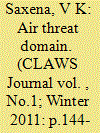

|
|
|
| 4 |
ID:
093386


|
|
|
| 5 |
ID:
011988
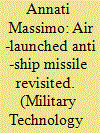

|
|
|
|
|
| Publication |
June 1997.
|
| Description |
66-73
|
|
|
|
|
|
|
|
|
|
|
|
|
|
|
|
| 6 |
ID:
055170
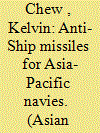

|
|
|
| 7 |
ID:
007554
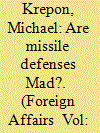

|
|
|
|
|
| Publication |
Jan-Feb 1995.
|
| Description |
19-24
|
|
|
|
|
|
|
|
|
|
|
|
|
|
|
|
| 8 |
ID:
082408


|
|
|
|
|
| Publication |
2008.
|
| Summary/Abstract |
This analysis examines ballistic missile proliferation in the context of strategic interactions among neighboring states. The analysis finds that when faced with ballistic missile threats, nations respond rationally and acquire ballistic missiles as a deterrent. Using a panel data set of 119 countries from 1967 to 1997, this study shows that the probability of a country procuring ballistic missiles increases nonlinearly as the number of bordering states with ballistic missiles increases. Although international norms arising from the Missile Technology Control Regime reduced the probability of missile proliferation, these externalities did not offset a state's decision to arm in response to ballistic missile arsenals in neighboring states. This analysis also finds that surface-to-air missiles (SAMs) increased the probability of proliferation in two ways: first, because ballistic missiles provided states ``ensured penetration'' of a rival's air defenses; and second, because SAMs reduced the ability of a rival to retaliate against a ballistic missile attack
|
|
|
|
|
|
|
|
|
|
|
|
|
|
|
|
| 9 |
ID:
010500
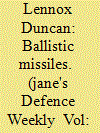

|
|
|
|
|
| Publication |
April 17, 1996.
|
| Description |
40-44
|
|
|
|
|
|
|
|
|
|
|
|
|
|
|
|
| 10 |
ID:
124141
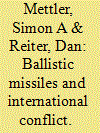

|
|
|
|
|
| Publication |
2013.
|
| Summary/Abstract |
Governments are concerned about the dangers posed by ballistic missiles. However, there is almost no theoretical or empirical scholarship on ballistic missiles. This article presents and tests the conventional wisdom that the spread of ballistic missiles makes conflict more likely. Original data on ballistic missiles and on crisis initiation is collected, and analysis using a variety of statistical models is conducted. It is found that among all directed dyads from 1946 to 2007, potential challengers possessing ballistic missiles are significantly more likely to initiate international crises. Further, potential targets armed with ballistic missiles are significantly less likely to be challenged. Crises are less likely to escalate when targets are armed with missiles. The results are obtained after accounting for several control variables. Analysis reveals that the findings are not affected by possible endogeneity bias. The analysis also reveals complex interactive effects between ballistic missiles and nuclear weapons on the onset of international crises.
|
|
|
|
|
|
|
|
|
|
|
|
|
|
|
|
| 11 |
ID:
014104
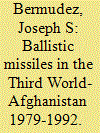

|
|
|
|
|
| Publication |
Feb 1992.
|
| Description |
51-58
|
|
|
|
|
|
|
|
|
|
|
|
|
|
|
|
| 12 |
ID:
146427
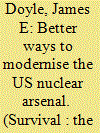

|
|
|
|
|
| Summary/Abstract |
The planned modernisation of the United States’ nuclear forces raises a number of national-security dilemmas that demand the nation’s full attention. Nuclear weapons can deter potential adversaries, but they also create the risk of a nuclear war that would destroy everything the United States seeks to protect. Maintaining too few nuclear weapons could create vulnerabilities, but building too many may lead to war by creating misperceptions of American intentions or consuming defence resources that are needed to address other urgent threats. Effective strategy therefore requires a balance of forces that can survive enemy attack and deliver devastating retaliation while promoting peaceful, stable relationships among states and minimising the chances of nuclear war, nuclear terrorism and further nuclear proliferation.
|
|
|
|
|
|
|
|
|
|
|
|
|
|
|
|
| 13 |
ID:
005265


|
|
|
|
|
| Publication |
Fairbairn, Air Power Studies Centre, 1994.
|
| Description |
23p.
|
| Series |
Air Power Studies Centre; 20
|
| Standard Number |
0642199183
|
|
|
|
|
|
|
|
|
|
|
|
Copies: C:1/I:0,R:0,Q:0
Circulation
| Accession# | Call# | Current Location | Status | Policy | Location |
| 036476 | 358.17/MAC 036476 | Main | On Shelf | General | |
|
|
|
|
| 14 |
ID:
143302
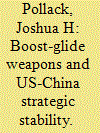

|
|
|
|
|
| Summary/Abstract |
The United States and China are testing boost-glide weapons, long-range strike systems capable of flying at Mach 5 or faster through the upper atmosphere. For the United States, these systems would provide a conventional prompt global strike capability, which, together with US ballistic missile defense programs, Chinese experts regard as a threat to China's ability to conduct nuclear retaliation. This perception is encouraging the Chinese military to modify its nuclear posture in ways that tend to create greater risks for both sides. If China's own boost-glide systems are meant to carry nuclear payloads only, their deployment would not fundamentally alter the current situation between the two states. However, if they were conventionally armed or dual-purpose, or if the United States could not determine the payloads they carried, the deployment of Chinese boost-glide systems could compound problems of strategic stability created by the introduction of ballistic missile defense, antisatellite, and antiship ballistic missile capabilities. If the technical hurdles can be overcome, it may be difficult for the two sides to refrain from these deployments in the absence of strong mutual trust or an established arms-control relationship. New confidence-building measures and expanded mutual transparency are warranted to avoid creating new dangers.
|
|
|
|
|
|
|
|
|
|
|
|
|
|
|
|
| 15 |
ID:
006660


|
|
|
|
|
| Publication |
London, Brassey's, 1996.
|
| Description |
672p.
|
| Standard Number |
1-85753-198-1
|
|
|
|
|
|
|
|
|
|
|
|
Copies: C:1/I:0,R:0,Q:0
Circulation
| Accession# | Call# | Current Location | Status | Policy | Location |
| 038434 | R 623.74603/TAY 038434 | Main | On Shelf | General | |
|
|
|
|
| 16 |
ID:
142579
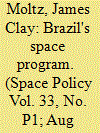

|
|
|
|
|
| Summary/Abstract |
Brazil's space program represents an anomaly among those of the world's 10 largest economic powers. During a time that has witnessed the rapid emergence of a variety of national space programs—even among lesser powers like Iran and South Korea–Brazil's failure to emerge as a significant space actor requires further analysis. This article traces the history of Brazil's space efforts and examines the factors that have held it back, some of which continue to influence its policies today: inadequate funding, conflicting organizations, poorly handled foreign relations, and an unclear national vision for Brazil's “place” in space. Recent efforts to overcome these hurdles through an improved domestic strategy and smarter international relations show promise. But a more sustained political commitment to space development will be needed if they are to succeed.
|
|
|
|
|
|
|
|
|
|
|
|
|
|
|
|
| 17 |
ID:
049749
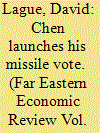

|
|
|
| 18 |
ID:
186333


|
|
|
|
|
| Summary/Abstract |
Why do some states possess more advanced military technologies than others? Our study explores the vertical proliferation of land-attack cruise missiles (LACMs), seeking to understand which demand- and supply-side factors best explain why some countries acquire more sophisticated LACMs. We theorize that states’ security environments, regime types, possession of related strategic technologies, and membership in the Missile Technology Control Regime (MTCR) influence the possession of more sophisticated cruise missiles. Our analysis employs a unique new global dataset with granular data on every LACM national militaries have deployed. We use this dataset to evaluate the proliferation of LACMs across the international system from 1991–2015. Using a selection model that first controls for the horizontal proliferation of LACMs, we find that insecurity, scientific and technical expertise from related technologies, the possession of highly authoritarian and highly democratic regimes, and MTCR membership all have positive effects on the sophistication of LACM-possessors’ arsenals.
|
|
|
|
|
|
|
|
|
|
|
|
|
|
|
|
| 19 |
ID:
182644
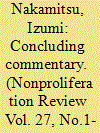

|
|
|
|
|
| Summary/Abstract |
The United Nations High Representative for Disarmament Affairs offers concluding thoughts on this special issue of the Nonproliferation Review, highlighting recent work that the international community has undertaken on the challenges of long-range conventional weapons, and offering recommendations for ameliorating the effects these weapons may have on strategic stability and international peace and security.
|
|
|
|
|
|
|
|
|
|
|
|
|
|
|
|
| 20 |
ID:
099707
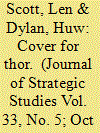

|
|
|
|
|
| Publication |
2010.
|
| Summary/Abstract |
In the late 1950s, as intercontinental ballistic missiles (ICBMs) replaced bombers, the development of Soviet ICBMs prompted fears of strategic vulnerability in the West. The Eisenhower administration's decision to deploy Intermediate Range Ballistic Missiles (IRBMs) on the territory of NATO allies sought to redress the perceived vulnerability until American ICBMs were ready. British deception planners considered how to enhance the threat posed by the IRBMs. An outline plan codenamed 'Celestial' was intended to persuade the Soviets that the otherwise vulnerable missiles could not be readily neutralised. This article explores this deception and how such planning also sought to convey accurate information alongside disinformation. It also suggests that deception planners appear to have given little heed to the potentially counterproductive consequences of such an operation.
|
|
|
|
|
|
|
|
|
|
|
|
|
|
|
|